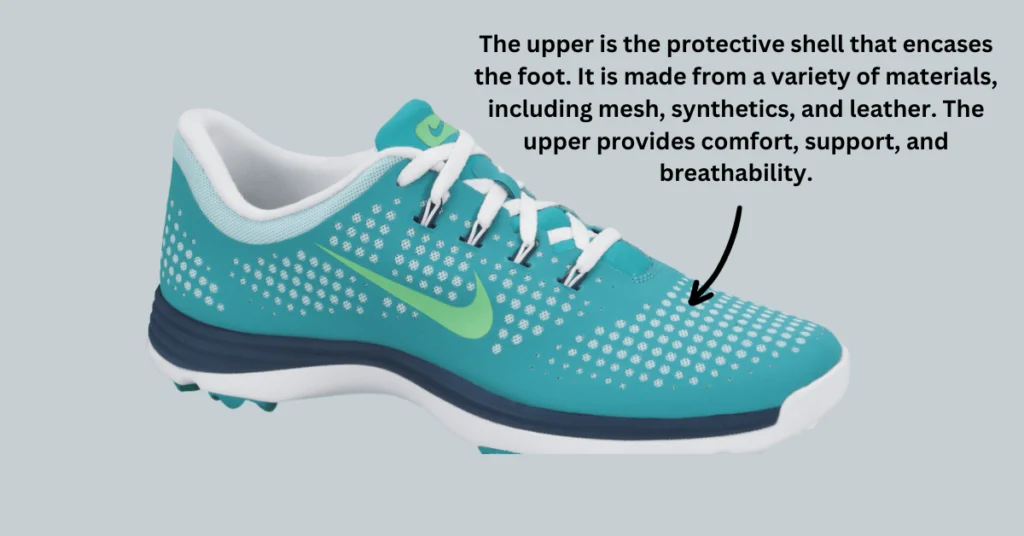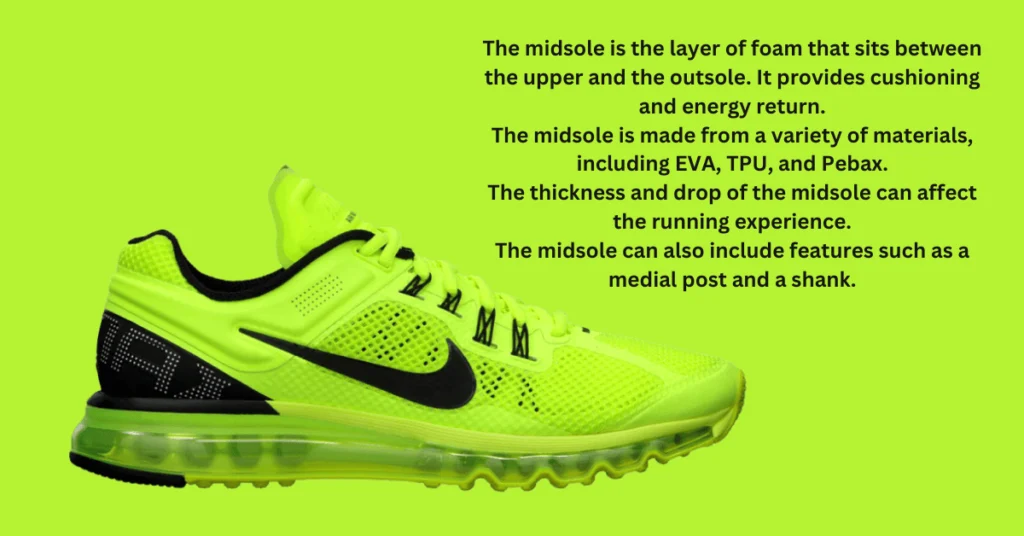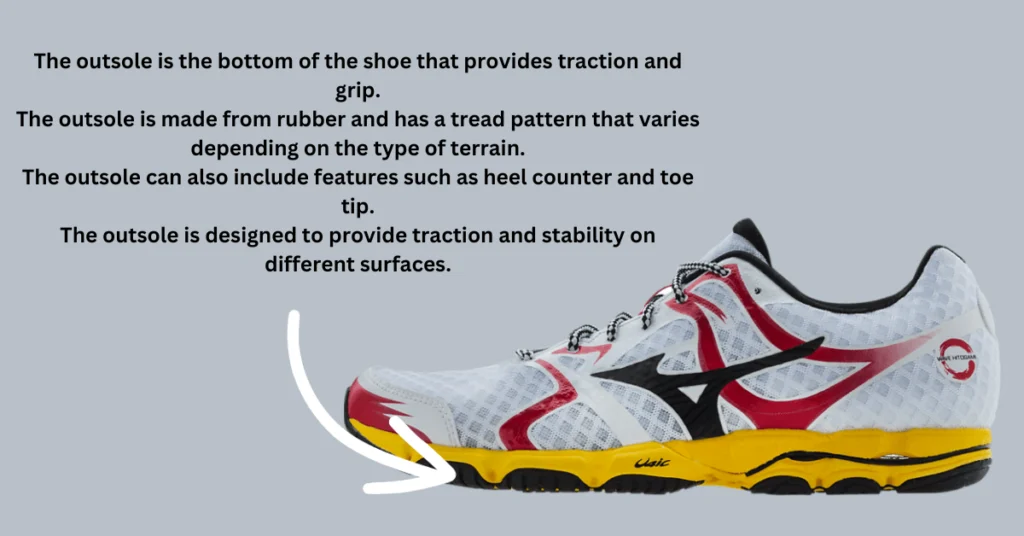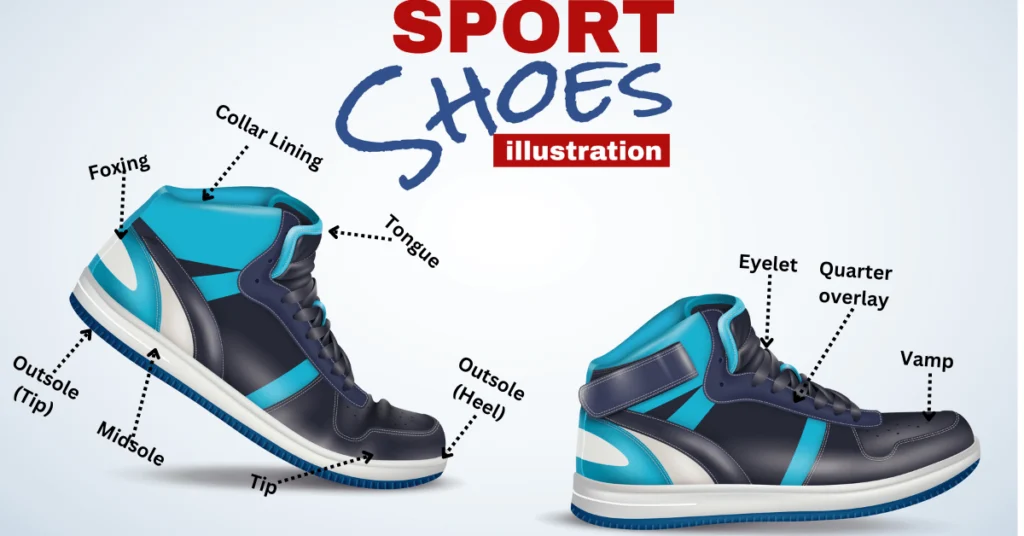Have you ever thought about how the anatomy of a running shoe impacts your running performance?
In the realm of athletic footwear, running shoes stand out as the cornerstone of a runner’s journey, serving as faithful companions on countless miles of training and competition. Yet, beneath their seemingly straightforward exterior lies a complex anatomy, a symphony of components meticulously designed to enhance performance and promote comfort. Understanding the anatomy of a running shoe is akin to unlocking a secret code, empowering runners to make informed decisions and select the ideal footwear for their unique needs.
The anatomy of a running shoe begins with the upper, the protective shell that encases the foot. Crafted from various materials, from breathable mesh to supple leather, the upper provides a snug, comfortable fit while allowing optimal ventilation. Beneath the upper lies the midsole, the heart of cushioning and energy return. This layer of foam, often composed of advanced materials like EVA or Pebax, absorbs impact, reduces fatigue, and propels the runner forward with newfound vigor.
Connecting the midsole to the ground is the outsole, the grippy interface that translates power into traction. Its intricate tread pattern, designed for specific terrains, ensures stability and control, whether conquering rugged trails or navigating city streets. Within the shoe, hidden from view yet crucial to performance, lies the shank, a rigid insert that maintains structural integrity and prevents excessive torsion. For extra comfort, the sock liner, a removable layer of soft material, provides cushioning, moisture management, and odor control.
The anatomy of a running shoe is not merely a collection of parts; it is a testament to human ingenuity, a symphony of design and engineering that elevates the simple act of running to an art form. By understanding the intricacies of this intricate system, runners can unlock new levels of performance, transforming their runs from mundane errands into exhilarating adventures.
Glossary of Essential Components
Upper
- Toe box: The protective area at the front of the shoe that accommodates the toes
- Vamp: The flexible material that covers the top of the foot
- Tongue: The padded piece of fabric that covers the instep and provides comfort and lacing support
- Eyelets: The small holes through which the laces pass to secure the shoe to the foot
- Laces: The cords used to fasten the shoe and provide a snug fit
Midsole
- Midsole foam: The primary cushioning layer that absorbs impact and provides support
- Medial post: A raised portion of the midsole that helps control excessive pronation
- Shank: A rigid plate or board embedded in the midsole to maintain shoe structure and reduce torsion
- Crash pad: A soft, compressible area at the heel that helps absorb impact during a heel strike
Outsole
- Tread: The pattern of raised lugs on the outsole that provides traction and grip on different surfaces
- Heel counter: A stiff, supportive piece of material that surrounds the heel to provide stability and prevent ankle roll
- Outsole rubber: The durable material that forms the bottom of the shoe and provides traction and wear resistance
- Toe tip: A thin rubber strip at the front of the outsole that protects the toe from abrasion
Additional Components
- Sockliner: A removable insole that provides cushioning, moisture management, and odor control
- Heel stabilizer: An injection-molded piece of plastic that enhances heel stability and control
- Mudguard: A protective layer of rubber or plastic that wraps around the front of the shoe to prevent mud and debris from entering
- The spring: The upward curvature of the sole from the toe to the ball of the foot, which promotes a natural toe-off during running
- Lace keeper: A small flap that holds the laces in place and prevents them from flapping
Related
7 Best Shoes for Calisthenics and Other Sports Activities
The Upper: The Foundation of a Running Shoe
As the first point of contact between the foot and the shoe, the upper plays a pivotal role in ensuring comfort, support, and breathability. Its design and construction directly impact the overall running experience, influencing everything from preventing blisters and chafing to enhancing performance and promoting a natural stride.

Materials and Construction: A Symphony of Comfort and Support
The upper is typically crafted from various materials, each with unique properties. Breathable mesh, a common choice, allows optimal ventilation, keeping feet cool and dry even during intense workouts. Synthetics, such as nylon or polyester, offer enhanced durability and weather resistance, while leather, a classic choice, provides a luxurious feel and timeless elegance.
The construction of the upper also plays a crucial role in its effectiveness. Seamless construction, achieved through heat-bonding or ultrasonic welding, eliminates stitching and reduces the risk of chafing and irritation. Overlays, strategically placed reinforcements, provide targeted support in areas like the midfoot and heel.
The Toe Box: A Sanctuary for Wiggling Toes
The toe box, the protective enclosure at the front of the shoe, is a haven for active toes. Its ample size and shape allow toes to splay naturally, preventing discomfort and promoting efficient power transfer. A too-narrow toe box can lead to cramped toes, blisters, and even altered foot biomechanics.
The Tongue: A Protective Guardian
The tongue, a padded material covering the instep, is a protective barrier between the laces and the foot. It distributes lace pressure evenly, preventing discomfort and potential injury. A well-designed tongue also enhances the ease of putting on and removing the shoe.
Lacing System: A Symphony of Adjustability
The lacing system, the intricate network of eyelets and laces, is the key to a secure and customized fit. Eye-let placement allows targeted adjustments, ensuring a snug fit around the entire foot. Adjustable laces, whether traditional or elastic, provide further customization, catering to individual preferences and foot shapes.
The upper, in its entirety, is an intricate tapestry of materials, construction techniques, and design elements. It is the foundation upon which the running experience is built, ensuring comfort, support, and breathability while adapting to each runner’s unique contours and needs.
The Midsole: The Heart of Cushioning and Energy Return

Beneath the upper lies the midsole, the unsung hero of the running shoe, responsible for cushioning impact, providing energy return, and enhancing overall performance. This crucial layer of foam, often composed of advanced materials like EVA (ethylene-vinyl acetate) or Pebax (polyamide block copolymer), is the cornerstone of a runner’s comfort and efficiency.
Cushioning: A Cradle for Impact Absorption
The primary function of the midsole is to absorb the impact forces generated with each foot strike. As the foot hits the ground, the midsole compresses, dissipating the shock and reducing the strain on the feet, joints, and lower body. This cushioning is particularly important for heel-rike runners, who experience higher impact forces than forefoot or midfoot strikers.
Energy Return: Propelling Runners Forward
The midsole’s role extends beyond mere cushioning. It also plays a crucial role in energy return, converting the energy absorbed during impact into forward propulsion. As the midsole rebounds from compression, it stores the energy released with each stride, propelling the runner forward with a sense of effortless power.
Material Matters: A Symphony of Foam Technologies
The choice of midsole material significantly impacts a running shoe’s cushioning and energy return properties. EVA, a versatile and lightweight foam, is a common choice, offering a balance of cushioning and responsiveness. Pebax, a newer material, is known for its superior energy return and lightweight properties.
Midsole Design: A Tale of Thickness and Drop
The design of the midsole, particularly its thickness and drop, further influences the running experience. Midsole thickness is directly related to the level of cushioning. A thicker midsole provides more shock absorption, while a thinner midsole offers a more responsive feel.
Midsole drop, the difference in height between the heel and forefoot, also plays a role in running dynamics. A higher drop promotes a heel-striking gait, while a lower drop encourages a midfoot or forefoot strike. The choice of midsole drop depends on individual running styles and preferences.
Medial Post: A Guardian Against Pronation
For runners who pronate excessively, the midsole often incorporates a medial post, a raised portion of firmer foam on the medial side of the shoe. This post helps control the inward rolling of the foot during pronation, promoting stability and reducing the risk of injuries.
Shank: A Rigid Backbone for Structural Integrity
Embedded within the midsole, often concealed from view, lies the shank, a rigid plate or board that provides structural integrity and prevents excessive torsion. The leg helps maintain the shoe’s shape, preventing it from collapsing under the runner’s weight.
Heel Stabilizer: A Guardian Against Ankle Roll
In some running shoes, a heel stabilizer, an injection-molded piece of plastic, is incorporated into the midsole. This stabilizer provides additional support and control around the heel, reducing the risk of ankle roll, particularly during uneven terrain or trail running.
The midsole, in its entirety, is a masterpiece of engineering, a symphony of materials, design, and technology. It is the heart of the running shoe, providing cushioning, energy return, and stability, transforming running into a journey of comfort, efficiency, and effortless performance.
Related
The Importance of Good Shoes for Calisthenics and Other Sports Activities
The Outsole: The Grip on the Ground

The outsole, the final piece of the running shoe puzzle, is the runner and the ground interface. This crucial layer of rubber provides traction, stability, and durability, adapting to various terrains and conditions to ensure optimal performance.
Tread Pattern: A Symphony of Grip
The outsole’s tread pattern, the intricate arrangement of raised lugs or bumps, is the key to its ability to provide traction and grip. Different tread patterns are designed for specific terrains, catering to the unique challenges of each surface.
Aggressive tread patterns with deep lugs for trail running provide traction on loose dirt, rocks, and roots. On pavement, shallower lugs are suitable for maintaining grip without excessive noise or wear. For indoor running, smooth outsoles provide a secure grip on polished surfaces.
Heel Counter: A Guardian Against Ankle Roll
The heel counter, a stiff, supportive material surrounding the heel, plays a crucial role in stability and ankle protection. It prevents excessive inward or outward rolling of the heel, reducing the risk of ankle sprains, particularly during uneven terrain or trail running.
Outsole Rubber: A Symphony of Durability
The outsole rubber, the material that forms the bottom of the shoe, is selected for its durability and ability to provide traction on various surfaces. Carbon rubber, a dense and durable material, is a common choice for high-performance shoes. Blown rubber, a lighter and more flexible material, is often used in forefoot areas for increased comfort and flexibility.
Toe Tip: A Guardian Against Wear and Tear
The toe tip, a thin rubber strip at the front of the outsole, protects the toe from abrasion and wear, particularly during uphill or toe-off movements. It extends the shoe’s lifespan and reduces the risk of premature damage.
Mudguard: A Protector Against Debris
For off-road running, a mudguard, a protective layer of rubber or plastic, is often incorporated into the outsole. This mudguard wraps around the front and sides of the shoe, preventing mud, debris, and water from entering and clogging the tread pattern.
Outsole Design: A Symphony of Performance
The outsole’s design extends beyond the tread pattern, encompassing various features that enhance performance. Flex grooves, strategically placed cuts in the outsole, allow the shoe to bend naturally with the foot’s movement, promoting flexibility and comfort. Toe spring, the upward curvature of the sole from the toe to the ball of the foot, mimics the foot’s natural rolling motion, encouraging a smooth transition from heel strike to toe-off.
The outsole, in its entirety, is a testament to innovation and engineering, a symphony of materials, design, and technology. It is the final touch to the running shoe, transforming it from mere footwear into a companion on countless miles of adventure and performance.
Additional Components: Enhancing the Running Experience
Beyond the core components of the upper, midsole, and outsole, several additional features contribute to the overall running experience, enhancing comfort, performance, and durability.
Sockliner: A Symphony of Comfort and Moisture Management
The sock liner, a removable insole that sits directly atop the midsole, provides cushioning, moisture management, and odor control. It often incorporates a combination of foam and fabric, ensuring a comfortable and supportive fit. Some sock liners feature advanced technologies, such as antimicrobial treatments or moisture-wicking properties, to keep feet dry and odor-free.
Heel Stabilizer: A Guardian Against Heel Roll
In addition to the heel counter incorporated into the midsole, some running shoes feature an external heel stabilizer, a separate piece of plastic or molded foam that provides additional support and control around the heel. This feature mainly benefits runners who pronate excessively or require extra stability on uneven terrain.
Lace Keeper: A Symphony of Organization
The lace keeper, a small flap or loop of fabric or plastic, serves a simple yet essential function: keeping laces secure and preventing them from flapping. This seemingly minor detail contributes to a distraction-free running experience.
Mudguard: A Protector Against Debris
For off-road running, a mudguard, a protective layer of rubber or plastic, is often incorporated into the outsole. This mudguard wraps around the front and sides of the shoe, preventing mud, debris, and water from entering and clogging the tread pattern.
Toe Spring: A Symphony of Efficiency
Toe spring, the upward curvature of the sole from the toe to the ball of the foot, mimics the foot’s natural rolling motion, encouraging a smooth transition from heel strike to toe-off. This feature promotes a more efficient and comfortable running stride.
Additional Components: Enhancing the Running Experience
Beyond the core components of the upper, midsole, and outsole, several additional features contribute to the overall running experience, enhancing comfort, performance, and durability.
Sockliner: A Symphony of Comfort and Moisture Management
The sock liner, a removable insole that sits directly atop the midsole, provides cushioning, moisture management, and odor control. It often incorporates a combination of foam and fabric, ensuring a comfortable and supportive fit. Some sock liners feature advanced technologies, such as antimicrobial treatments or moisture-wicking properties, to keep feet dry and odor-free.
Heel Stabilizer: A Guardian Against Heel Roll
In addition to the heel counter incorporated into the midsole, some running shoes feature an external heel stabilizer, a separate piece of plastic or molded foam that provides additional support and control around the heel. This feature mainly benefits runners who pronate excessively or require extra stability on uneven terrain.
Lace Keeper: A Symphony of Organization
The lace keeper, a small flap or loop of fabric or plastic, serves a simple yet essential function: keeping laces secure and preventing them from flapping. This seemingly minor detail contributes to a distraction-free running experience.
Mudguard: A Protector Against Debris
For off-road running, a mudguard, a protective layer of rubber or plastic, is often incorporated into the outsole. This mudguard wraps around the front and sides of the shoe, preventing mud, debris, and water from entering and clogging the tread pattern.
Toe Spring: A Symphony of Efficiency
Toe spring, the upward curvature of the sole from the toe to the ball of the foot, mimics the foot’s natural rolling motion, encouraging a smooth transition from heel strike to toe-off. This feature promotes a more efficient and comfortable running stride.
Conclusion
Understanding the anatomy of a running shoe is essential for achieving peak performance. The appropriately designed shoe will not only give you extra comfort but will also help prevent injuries. So, choosing the right shoes for running is of paramount importance. Take that decision wisely.
FAQs
What are the main components of a running shoe?
The main components of a running shoe are the upper, midsole, and outsole. The upper provides comfort and support, the midsole provides cushioning and energy return, and the outsole provides traction and grip.
How do I choose the right running shoe for my foot type?
There are three main types of foot types: high arches, low arches, and normal arches. High arches require shoes with additional cushioning and support, low arches require shoes with motion control features, and normal arches require shoes with neutral cushioning and support.
What is the difference between a trail running shoe and a road running shoe?
Trail running shoes are designed for off-road surfaces and feature aggressive tread patterns for traction. Road running shoes are designed for pavement and smooth surfaces and prioritize cushioning and lightweight construction.
Where can I get help selecting the right running shoe?
Running specialty stores offer gait analysis services and personalized recommendations to help you find the perfect running shoe for your individual needs.
Hello, fellow fitness enthusiasts! I'm Zayn, a Board Certified Fitness and Nutrition Coach. My journey started from a personal commitment to fitness, and over time, this passion ignited a desire to help others unlock their potential. I transformed this passion into my profession, and today, I'm proud to say that I am armed with a plethora of certifications, all testament to my dedication and commitment.
When I'm not advising clients or working on my next blog post, you'll find me trying out new fitness regimes, diving into the latest nutritional research, or practicing what I preach with my own healthy lifestyle. My mission is to help you become the best version of yourself, showing that fitness and nutrition are as much about the journey as they are about the destination.



Pingback: How to Find Maintenance Calories? -